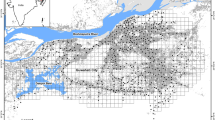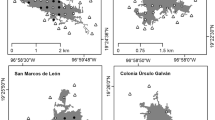Abstract
The house sparrow (Passer domesticus) is showing population declines in many parts of Europe, with recent declines being particularly severe in urban areas. To date, relatively little is known about the species’ habitat associations within urbanized landscapes. We report here an investigation of the habitat associations of house sparrows using a survey of 1223 stratified randomly selected 500 × 500-m squares within urbanized landscapes of the UK, defined as at least 25% ‘human cover’. The densities of chirping male house sparrows and of all house sparrows were analysed separately to obtain insights into breeding habitat requirements and general habitat associations, respectively. Multi-model inference showed that residential areas (houses, flats), allotments (areas used for small-scale horticulture) and farm buildings were key predictors of house sparrow density and chirping male density. Separate analyses on landscapes of differing human cover showed similar results. Within residential areas, the increase of house sparrow density with habitat area (on a log scale) was approximately threefold greater when private gardens were present than when they were absent. The model predicted a rapid decline in house sparrow abundance when only a small area of private gardens is converted to continuous housing. Allotments and residential areas with gardens are likely to be under pressure due to increased demand for housing, specifically from the infilling of green space within urban areas. It would seem to be imperative that any action plan to protect urban house sparrow populations should include specific protection of such key habitats.



Similar content being viewed by others
References
Anderson TR (2006) Biology of the ubiquitous house sparrow. Oxford University Press, Oxford
Baillie SR, Marchant JH, Crick HQP, Noble DG, Balmer DE, Coombes RH, Downie IS, Freeman SN, Joys AC, Leech DI, Raven MJ, Robinson RA, Thewlis RM (2006) Breeding birds in the wider countryside: their conservation status 2005. BTO research report no. 435. British Trust for Ornithology (BTO), Thetford
Bland RL (1998) House sparrow densities in Bristol. Avon Bird Rep 1998:145–148
Burnham KP, Anderson DR (2002) Model selection and multimodel inference. A practical information-theoretic approach. 2nd edn. Springer, New York
Cannon AR, Chamberlain DE, Toms MP, Hatchwell BJ, Gaston KJ (2005) Trends in the use of private gardens by wild birds 1995–2002. J Appl Ecol 42:659–671
Chamberlain DE, Vickery JA, Glue DE, Robinson RA, Conway GJ, Woodburn RJW, Cannon AR (2005) Annual and seasonal trends in the use of garden feeders by birds in winter. Ibis 147:563–575
Crick HQP, Robinson RA, Appleton GF, Clark NA, Rickard AD (2002) Investigation into the causes of the decline of Starlings and House Sparrows in Great Britain. British Trust for Ornithology (BTO), Thetford
Dawson D, Gittings T (1990) The effect of suburban residential density on birds. Report to the London Borough of Sutton. London Ecology Unit, London
Dröscher VB (1992) Unse Spatz piepst das Lied von Tod. Bunte 30:78–81
Fuller RJ, Marchant JH, Morgan RA (1985) How representative of agricultural practice in Britain are common bird census farmland plots. Bird Study 32:56–70
Fuller RM, Smith GM, Sanderson JM, Hill RA, Thompson AG (2002) Land Cover Map 2000: a general description of the UK’s new vector GIS based on classification of remotely sensed data. Cartogr J 39:15–25
Heij CJ (1985) Comparative ecology of the House Sparrow Passer domesticus in rural, suburban and urban situations. PhD thesis, University of Amsterdam, Amsterdam
Hole DG, Whittingham MJ, Bradbury RB, Anderson GQA, Lee PLM, Wilson JD, Krebs JR (2002) Agriculture: widespread and local house-sparrow extinctions. Nature 418:931–932
Gregory RD, Eaton MA, Noble DG, Robinson G, Parsons M, Baker H, Austin G, Hilton MA (2003) The state of the UK’s birds 2002. RSPB/BTO/WWT/JNCC, Sandy, UK
Krebs CJ (1989) Ecological methodology. Harper & Row, New York
Mason CF (2006) Avian species richness and numbers in the built environment: can new housing developments be good for birds? Biodivers Conserv 15:2365–2378
Mitsche A (1999) Ornithologischer Jahresbericht 1996 und 1997 für das das Hamburger Berichtsgebeit. Hamburger Avifauna Beitr 30:129–204
Paston S (2000) The House Sparrow in Norwich during autumn/winter 2000—A population study. Norfolk Bird Mammal Rep 34:289–293
Robinson RA, Siriwardena GM, Crick HQP (2005) Size and trends of the House Sparrow Passer domesticus population in Great Britain. Ibis 147:552–562
Shrubb M (2003) Birds, scythes and combines. A history of birds and agricultural change. Cambridge University Press, Cambridge
Siriwardena GM, Robinson RA, Crick HQP (2002) Status and population trends of the house sparrow Passer domesticus in Great Britain. In: Crick HQP, Robinson RA, Appleton GF, Clark NA, Rickard AD (eds) Investigation into the causes of the decline of starlings and house sparrows in Great Britain. British Trust for Ornithology (BTO), Thetford, pp 33–52
Summers-Smith JD (1963) The house sparrow. Collins, London
Summers-Smith JD (2003) The decline of the House Sparrow: a review. Brit Birds 96:439–446
Toms M (2003) The BTO/CJ garden BirdWatch book. British Trust for Ornithology (BTO), Thetford
Wilkinson N (2006) Factors influencing the small-scale distribution of House Sparrows Passer domesticus in a suburban environment. Bird Study 53:39–46
Wooton SR, Field R, Langston RHW, Gibbons DW (2002) Homes for birds: the use of houses for nesting by birds in the UK. Brit Birds 95:586–592
Ackowledgements
We would first like to extend our sincere gratitude to all participants of the BTO’s House Sparrow Survey. We would also like to thank Viola Kimmel for GIS support. This work was funded through the BTO House Sparrow Appeal; an appeal to BTO supporters and, in particular, the John Spedan Lewis Charitable Trust, Leslie Mary Carter Charitable Trust, Salter Charitable Trust and Elsie Mary Elkes Charitable Trust. Remotely-sensed land cover data were derived from the LCM2000 data base provided by the Centre for Ecology and Hydrology.
Author information
Authors and Affiliations
Corresponding author
Additional information
Communicated by F. Bairlein.
Electronic supplementary material
Below is the link to the electronic supplementary material.
10336_2007_165_MOESM1_ESM.doc
Appendix A. Habitat types recorded in the survey. Note that there were 28 habitattypes listed in the survey instructions but many observers added additional habitattypes. These were mostly assigned to a ‘Miscellaneous’ category, but a separate category of ‘Roads’ was created as this was commonly recorded. N is the total number of habitat patches recorded. A total of 1223 survey squares were surveyed. (DOC 41 kb)
Rights and permissions
About this article
Cite this article
Chamberlain, D.E., Toms, M.P., Cleary-McHarg, R. et al. House sparrow (Passer domesticus) habitat use in urbanized landscapes. J Ornithol 148, 453–462 (2007). https://doi.org/10.1007/s10336-007-0165-x
Received:
Revised:
Accepted:
Published:
Issue Date:
DOI: https://doi.org/10.1007/s10336-007-0165-x




